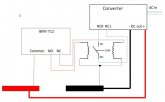I am hoping someone can help me find a solution. I am learning about relays and hoping to incorporate one to cut the power between my array and solar charge controller. 400w array, 45A SCC.
My "thought" was to use an NO (normally open) relay but wondering how i would power a "close" in the event of a BMS cutoff or other loss of battery power (goal: stop power to the SCC). With a power loss (or a BMS cutting power), it seems i cannot close the relay - doh!
So if I were to use an NC (normally closed) relay, I would need to power it "open" 24/7/365 using at least an amp of power. And I am guessing holding the switch open all the time, would shorten the life of the relay significantly.
Is there something other than a relay I should consider?
Some fundamentals: A relay is a switch that is toggled internally by a electromagnet coil pulling against a spring. Normally Open relays is the connection is open (power will not flow through) without any voltage being applied to the coil and the internal spring is holding it open. Normally Closed is the switch is closed (connection made) and the spring holds it closed without power applied to the coils.
A latching relay is one without a internal spring, it toggles open or closed and stays there (latches) until you hit the coil again with the opposite polarity and the switch moves again. There are MANY types of latching relays but swapping polarity at the coil is the most common type by a small margin. This is usually accomplished by an extra post on the relay.
You can turn any relay/contactor into a 'normally open' or a 'normally closed' by the addition of a inexpensive relay control board (which itself has a small relay on it) and connecting your relay coils to the NO or NC side of the board output. As the relay control board only uses milliwatts its more efficient to have that held in a state and use a big Normally Closed contactor that'll open for your trigger event. That way you're not holding open a large relay and burning watts continuously and wearing out the coils. However continuous duty relay coils are made for just that: Continuous duty, cheapo relays may say continuous duty but they're usually not. The trigger signal can be just a few milliwatts.
The downside here is that if you lose your trigger power to the coil its going to stay closed.
For example the temperature drops below freezing and you want to cut off charging from the panels: Your triggering signal goes to the control board trigger input which switches its own relay closed which then allows power to flow to the contactor coils which opens it up as long as the event trigger is applied. Since I assume you live in a area where it's not below freezing most of the year this'd be the most power efficient.
You don't have to worry about overvoltage because thats what charge controllers are FOR.
The same logic can be applied to almost any situation: You have a config that operates in a usual state but want to change it so you have to apply power to relays to open up the circuit.
Con is that when your control circuitry fails its going to fail with things energized. Sooner or later control circuitry always, ALWAYS fails.
IMO you should spend the money on getting good quality NO continuous duty relays and then hold them closed with your control circuitry. Good quality relays really only burn a few watts and do NOT get hot when energized. When something fails it just doesnt work things have failed in a DE-energized condition.
For now I'd recommend you stay away from solid state relays, they're not as intuitively obvious as you'd think and it'll just confuse you.



